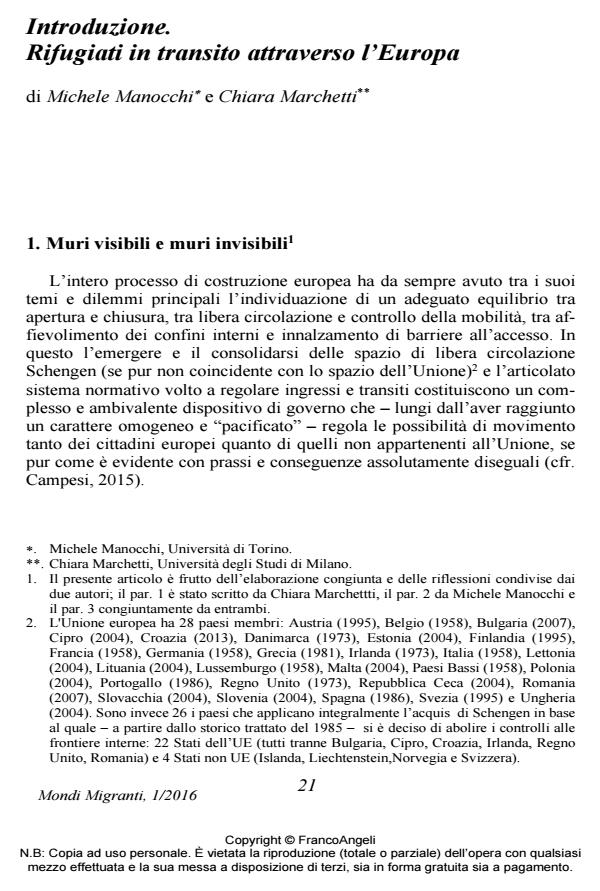Subjectivity en transit. (In) the mobility of refugees in Europe between control systems and daily practices of border crossing
Journal title MONDI MIGRANTI
Author/s Chiara Marchetti, Michele Manocchi
Publishing Year 2016 Issue 2016/1
Language Italian Pages 18 P. 21-38 File size 66 KB
DOI 10.3280/MM2016-001002
DOI is like a bar code for intellectual property: to have more infomation
click here
Below, you can see the article first page
If you want to buy this article in PDF format, you can do it, following the instructions to buy download credits

FrancoAngeli is member of Publishers International Linking Association, Inc (PILA), a not-for-profit association which run the CrossRef service enabling links to and from online scholarly content.
The article highlights the complexity of the forced migration phenomenon and the way through which the institutions attempt to manage and control it in Europe. The author sheds light on the power relations and the frictions that emerge from the interaction between the system of migration control and the migrant subjects' attempt to autonomously move. The concept of subjectivity is here applied in order to grasp the effect of the power relations and the practices of self formation enacted by subjects within the structural constrains in which they move. These dynamics will be highlighted by an ethnographic case-study about the "secondary movements" of a group of forced migrants that arrived in Italy in 2011 and moved later to Germany in order to find better life conditions, despite the restriction of their mobilities through the Schengen Agreement and Dublin Convention. The migrant subjects experience thus a transit condition, which is lengthened in time and assumes a spacial, temporal and juridical dimension - categories in transit from the "illegal" condition to the "legal" one and vice versa. Hence the transit condition becomes integral part of the migratory experience and not just a phase of transition. Thus, subjectivities in movement emerge, which are characterized by transit temporalities that confront themselves with the European, national and local institutions. The frictions which emerge from these interaction shed light on Europe as a battleground, where the negotiating practices between migrant subjects, institutional actors and supporters contribute to the redefinition of the territorial, juridical and political borders.
Keywords: Transits - borders - forced migration - subjectivities - temporalities - secondary movements
- Violenza Politica Giuliana Sanò, Stefania Spada, pp.17 (ISBN:9788867057603)
- Fare spazio all'accoglienza. Una riflessione sul progetto territoriale di accoglienza integrata di Roccagorga Sandra Annunziata, in MONDI MIGRANTI 1/2017 pp.39
DOI: 10.3280/MM2017-001003 - Introduzione. Le migrazioni lavorative intra-UE: modelli, pratiche e traiettorie di mobilità dei cittadini europei Devi Sacchetto, Francesca Alice Vianello, Rutvica Andrijasevic, in MONDI MIGRANTI 3/2017 pp.23
DOI: 10.3280/MM2016-003002 - Multilevel governance in trouble: the implementation of asylum seekers’ reception in Italy as a battleground Francesca Campomori, Maurizio Ambrosini, in Comparative Migration Studies 22/2020
DOI: 10.1186/s40878-020-00178-1 - Appréhender le risque dans l’espace-temps de l’attente à la frontière franco-britannique. Le cas des migrants en transit prolongé Marta Lotto, in Revue européenne des migrations internationales /2025 pp.77
DOI: 10.4000/13rq5 - Nuit debout. Transiti, connessioni e contestazioni negli accampamenti urbani dei rifugiati a Parigi Luca Queirolo Palmas, in MONDI MIGRANTI 2/2017 pp.207
DOI: 10.3280/MM2017-002011 - Entrapping Asylum Seekers Michele Manocchi, pp.217 (ISBN:978-1-137-58738-1)
- Asilo e crisi urbane: dinamiche di narrative-making tra media e policy network locali Andrea Pogliano, Irene Ponzo, in MONDI MIGRANTI 1/2019 pp.119
DOI: 10.3280/MM2019-001008 - Dentro, fuori e contro le involuzioni delle politiche sull'immigrazione: riflessioni dalle esperienze di microaccoglienza diffusa di richiedenti asilo in Valsugana e Valle di Susa Orlando De Gregorio, Elena Giacomelli, in MONDI MIGRANTI 2/2022 pp.165
DOI: 10.3280/MM2022-002008 - Il diritto di restare: il Regolamento Dublino, i volti, le storie e le possibili buone pratiche Ilaria Sommaruga, Annapaola Ammirati, in MONDI MIGRANTI 1/2018 pp.107
DOI: 10.3280/MM2018-001006 - Cibo e rifugiati nella città capitolina, tra pratiche di emergenza e tentativi di agentività Donatella Schmidt, Giovanna Palutan, in Archivio antropologico mediterraneo /2018
DOI: 10.4000/aam.854 - Underground Europe Luca Queirolo Palmas, Federico Rahola, pp.119 (ISBN:978-3-031-16150-6)
Chiara Marchetti, Michele Manocchi, Introduzione. Rifugiati in transito attraverso l’Europa in "MONDI MIGRANTI" 1/2016, pp 21-38, DOI: 10.3280/MM2016-001002